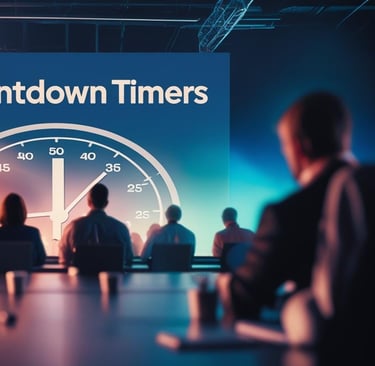Start sending invites for free - no card required - Click here
Countdown Timers: The Key to Professional Event Timing and Flow
Whether you're managing a virtual summit, a corporate webinar, or a large-scale conference, one thing remains universal: the importance of staying on schedule. In the age of short attention spans and back-to-back meetings, timing is everything. Countdown timers have quietly become the organizers' best friend — ensuring presenters stay within their slots and sessions don’t bleed into each other.
BLOGS
6/26/20252 min read


Whether you're managing a virtual summit, a corporate webinar, or a large-scale conference, one thing remains universal: the importance of staying on schedule. In the age of short attention spans and back-to-back meetings, timing is everything. Countdown timers have quietly become the organizers' best friend — ensuring presenters stay within their slots and sessions don’t bleed into each other.
In this article, we break down how to use countdown timers to create a more seamless, stress-free event experience.
Time Management: The Make or Break Factor
Even the best content can lose impact if delivered late or rushed. Using a conference timer or countdown timer for presenters allows organizers to plan effectively and execute their agendas without unnecessary delays.
By maintaining consistent pacing across sessions using tools like a countdown timer for webinar or a timer for speakers, the audience is more likely to remain engaged from start to finish.
Countdown Timers in Speaker-Led Sessions
Speakers often need help managing time without distraction. A countdown timer for speakers gives presenters real-time feedback on how much time remains, preventing awkward overflows and unplanned cut-offs.
Similarly, a timer for presenters is valuable in team presentations or co-hosted sessions where each speaker has a designated window. It subtly encourages presenters to be mindful of time, ensuring smooth transitions.
Seamless Session Management with Countdown Timers
Using a countdown timer for sessions helps keep all presentations aligned with the master schedule. From start to finish, sessions can be kept on track, minimizing downtime and maximizing content delivery.
In hybrid or live-streamed environments, such timers are often used to coordinate transitions between physical rooms and digital platforms. By displaying a visible countdown timer for stage, even live audiences are kept informed and ready for the next segment.
Why Use Timers Across All Event Formats?
Webinars: A webinar timer ensures you respect your attendees’ time, especially if they’ve committed an hour or less.
Virtual Summits: Countdown tools sync multiple tracks or breakout rooms.
On-Site Conferences: A conference timer provides cues to technicians, hosts, and speakers alike.
Multi-Speaker Sessions: A countdown timer for presenters maintains balance across shared segments.
Best Practices for Using Countdown Timers
Always Align Timers with the Agenda: Build timers directly into your session scripts.
Don’t Surprise the Speakers: Let everyone know about the countdown timer system in advance.
Keep Visibility Limited to Speakers: Attendees don’t need to see timers unless intentional.
Avoid Rigid Cutoffs: Flexibility is important — allow a minute or two buffer if needed.
Use for Transitions Too: Don’t just count session time — countdowns help prep audiences for what's coming next.
Closing Thoughts
Great events don’t happen by accident — they’re engineered with precision, and time is a key element in that equation. Whether you’re organizing a formal conference or a casual industry webinar, countdown timers help you stay on time and on message.
From managing session lengths to assisting speakers and technicians, using tools like a countdown timer for sessions or a countdown timer for stage can make your event more efficient and impactful.
So the next time you're planning a live or virtual event, remember — the clock isn’t just ticking for your audience, it’s working with you when you use it right.
BulkCalendar.in
Send Bulk & Mass Calendar Invites Instantly
Contact us
Engagement
sales@letscalendar.com
+44 (0) 203 916 5117
© 2025. All rights reserved.
Help?
